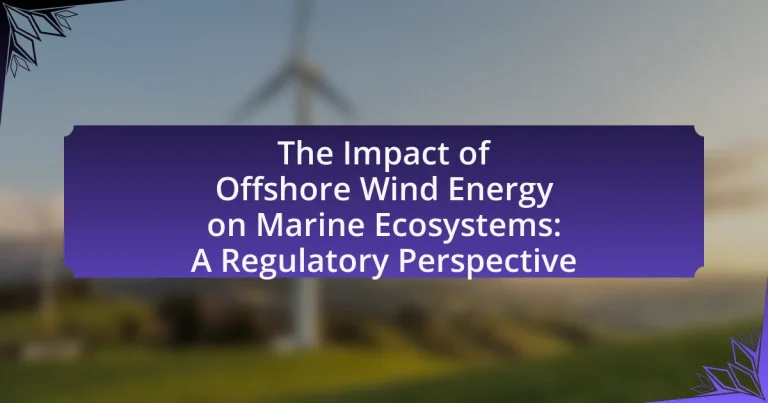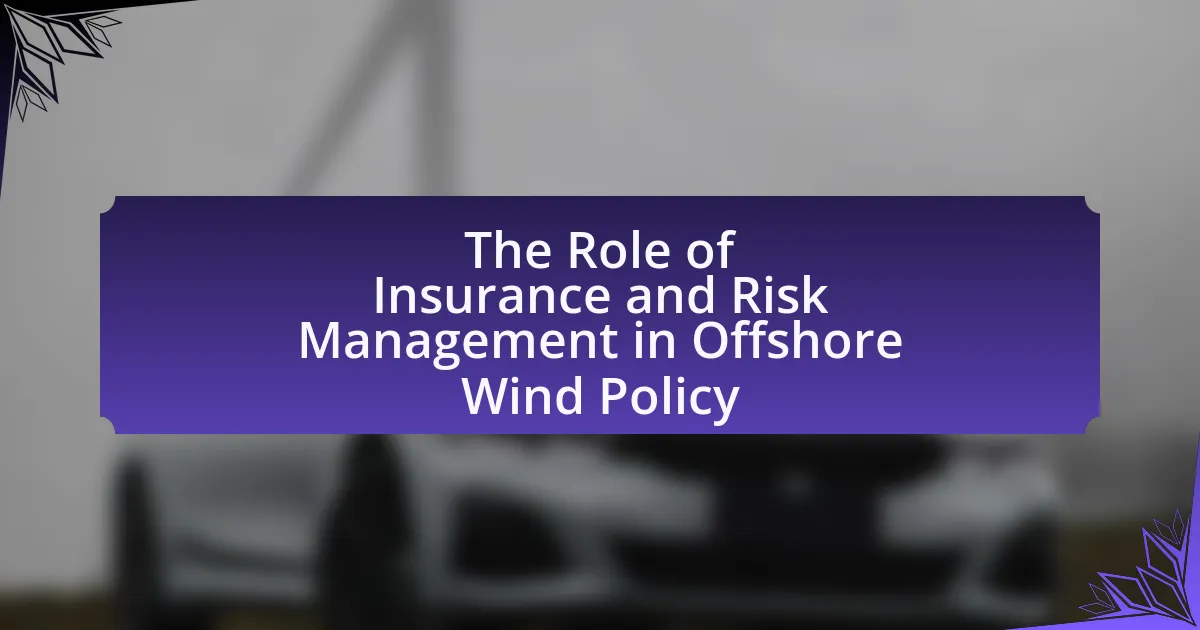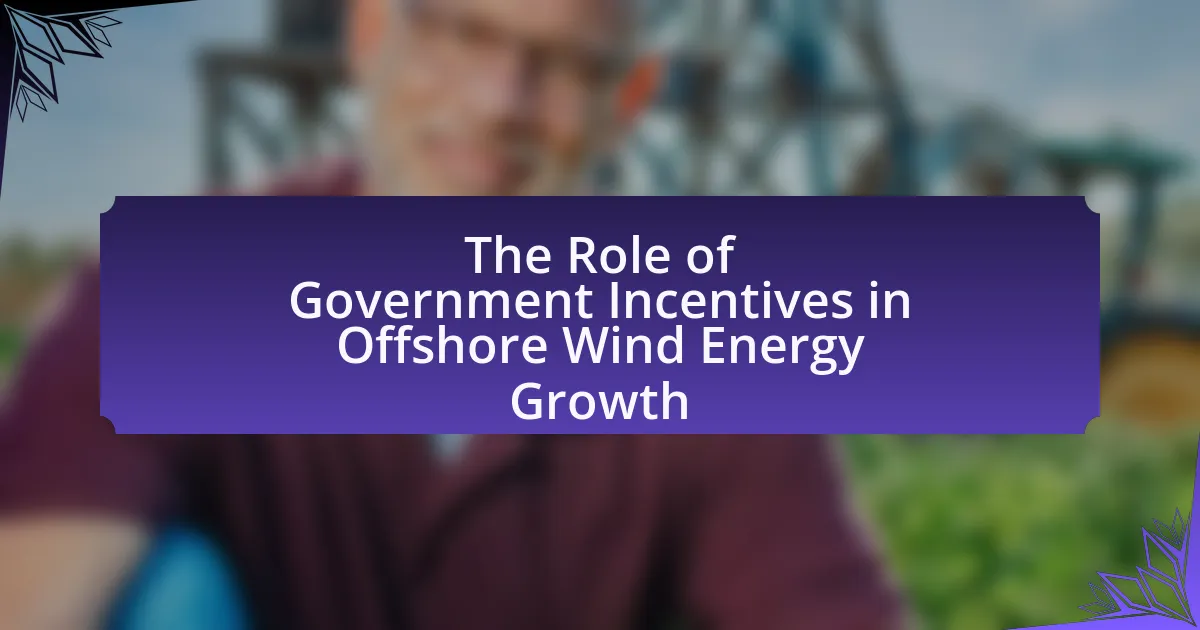The article examines the impact of offshore wind energy on marine ecosystems, emphasizing the regulatory frameworks that govern this development. It discusses how offshore wind farms can alter habitats, affect species distribution, and create both positive and negative ecological outcomes. Key species impacted include marine mammals, seabirds, and fish, with concerns regarding noise pollution and collision risks. The article also highlights the ecological benefits of offshore wind energy, such as carbon reduction and enhanced marine biodiversity through artificial reefs, while stressing the importance of comprehensive environmental assessments and stakeholder engagement in balancing energy needs with ecosystem protection.
What is the impact of offshore wind energy on marine ecosystems?
Offshore wind energy has a significant impact on marine ecosystems, primarily through habitat alteration and potential changes in species distribution. The construction and operation of wind farms can disrupt local habitats, affecting benthic organisms and altering sediment dynamics. Research indicates that the presence of wind turbines can create artificial reefs, which may enhance local biodiversity by providing new habitats for various marine species. Additionally, studies have shown that the noise generated during construction can affect marine mammals and fish behavior, potentially leading to changes in migration patterns. Overall, while offshore wind energy contributes to renewable energy goals, it necessitates careful management to mitigate its ecological impacts.
How does offshore wind energy development affect marine biodiversity?
Offshore wind energy development affects marine biodiversity primarily through habitat alteration and potential disruption of marine species. The construction and operation of wind farms can lead to changes in seabed habitats, which may impact benthic organisms and alter food webs. For instance, studies have shown that the presence of wind turbines can create artificial reefs, potentially benefiting some species while displacing others. Additionally, noise and vibration from construction activities can disturb marine mammals and fish, affecting their behavior and migration patterns. Research indicates that these impacts can vary significantly depending on the location and design of the wind farms, highlighting the need for careful environmental assessments and regulatory frameworks to mitigate adverse effects on marine ecosystems.
What specific species are most affected by offshore wind farms?
Offshore wind farms most significantly affect marine mammals, seabirds, and fish species. Marine mammals, such as harbor porpoises and seals, experience habitat disruption and increased noise pollution during construction and operation. Seabirds, including species like the northern gannet and puffins, face risks from collision with turbine blades and habitat alteration. Fish species, particularly those that rely on specific habitats like the sand eel, may be impacted by changes in water flow and sediment displacement. Studies indicate that these species are vulnerable to the ecological changes brought about by offshore wind energy development, highlighting the need for regulatory measures to mitigate these impacts.
How do offshore wind farms alter marine habitats?
Offshore wind farms alter marine habitats primarily by changing the physical environment and introducing new structures into the marine ecosystem. The installation of turbines and associated infrastructure can create artificial reefs, which may enhance local biodiversity by providing habitats for various marine species. Research indicates that these structures can attract fish and other marine organisms, leading to increased species richness in the area. Additionally, the presence of wind farms can affect sediment dynamics and water flow, which may influence the distribution of benthic organisms. Studies have shown that the alteration of habitats can lead to both positive and negative ecological outcomes, depending on the specific environmental context and the species involved.
What are the potential ecological benefits of offshore wind energy?
Offshore wind energy offers significant ecological benefits, including the reduction of greenhouse gas emissions and the promotion of marine biodiversity. By generating electricity without burning fossil fuels, offshore wind farms contribute to lower carbon emissions, which helps mitigate climate change and its associated impacts on marine ecosystems. Additionally, the structures of wind turbines can create artificial reefs, providing habitats for various marine species and enhancing local biodiversity. Research indicates that these installations can support fish populations and other marine life, leading to healthier ecosystems.
How can offshore wind farms contribute to marine conservation?
Offshore wind farms can contribute to marine conservation by creating artificial reefs that enhance biodiversity. The structures of wind turbines provide habitats for various marine species, promoting the growth of marine life in areas that may have been previously barren. Research indicates that these installations can lead to increased fish populations and improved ecosystem health, as observed in studies conducted in the North Sea, where wind farms have been shown to support higher densities of fish and other marine organisms compared to surrounding areas.
What role do offshore wind farms play in carbon reduction?
Offshore wind farms significantly contribute to carbon reduction by generating renewable energy that displaces fossil fuel use. By harnessing wind energy, these farms produce electricity without emitting carbon dioxide, which is a major greenhouse gas. According to the International Renewable Energy Agency, offshore wind energy can reduce carbon emissions by approximately 1.5 billion tons annually by 2030 if deployed at scale. This transition to cleaner energy sources is crucial for meeting global climate targets and mitigating the impacts of climate change.
What regulatory frameworks govern offshore wind energy and marine ecosystems?
Regulatory frameworks governing offshore wind energy and marine ecosystems include national laws, international agreements, and specific environmental regulations. In the United States, the Bureau of Ocean Energy Management (BOEM) oversees offshore wind development, ensuring compliance with the National Environmental Policy Act (NEPA) and the Endangered Species Act (ESA). In the European Union, the Renewable Energy Directive and the Marine Strategy Framework Directive guide member states in balancing renewable energy development with marine ecosystem protection. These frameworks are designed to mitigate environmental impacts, protect marine biodiversity, and promote sustainable energy practices.
How do international regulations impact offshore wind energy projects?
International regulations significantly influence offshore wind energy projects by establishing standards for environmental protection, safety, and operational procedures. These regulations, such as the European Union’s Renewable Energy Directive and the International Maritime Organization’s guidelines, ensure that projects minimize ecological disruption and adhere to sustainable practices. For instance, compliance with the Marine Strategy Framework Directive requires assessments of potential impacts on marine ecosystems, which can affect project design and implementation. Additionally, international agreements like the Paris Agreement promote renewable energy development, thereby encouraging investment in offshore wind projects while mandating adherence to climate goals.
What are the key international agreements relevant to offshore wind energy?
The key international agreements relevant to offshore wind energy include the Paris Agreement, the United Nations Convention on the Law of the Sea (UNCLOS), and the European Union’s Renewable Energy Directive. The Paris Agreement, adopted in 2015, aims to limit global warming and encourages the development of renewable energy sources, including offshore wind. UNCLOS provides a legal framework for the use of ocean resources, ensuring that offshore wind projects comply with maritime laws and environmental protections. The Renewable Energy Directive sets binding targets for renewable energy use within the EU, promoting offshore wind as a critical component of the region’s energy transition. These agreements collectively support the sustainable development of offshore wind energy while addressing environmental concerns.
How do these agreements address marine ecosystem protection?
These agreements address marine ecosystem protection by establishing regulatory frameworks that mandate environmental assessments and monitoring for offshore wind energy projects. Specifically, they require developers to evaluate potential impacts on marine habitats, species, and ecosystems before project approval. For instance, the European Union’s Marine Spatial Planning Directive emphasizes the need for sustainable use of marine resources, ensuring that offshore wind installations do not adversely affect marine biodiversity. Additionally, the United States’ National Environmental Policy Act necessitates comprehensive environmental reviews, which include public input and scientific data to safeguard marine ecosystems from potential disruptions caused by wind energy development.
What national regulations exist for offshore wind energy development?
National regulations for offshore wind energy development vary by country but generally include permitting processes, environmental assessments, and safety standards. In the United States, the Bureau of Ocean Energy Management (BOEM) oversees leasing and permitting, requiring environmental reviews under the National Environmental Policy Act (NEPA). In the United Kingdom, the Marine and Coastal Access Act governs offshore wind projects, mandating assessments of environmental impacts and public consultations. Additionally, the European Union has established directives that member states must follow, such as the Renewable Energy Directive, which sets targets for renewable energy production, including offshore wind. These regulations ensure that offshore wind energy development is conducted responsibly, balancing energy needs with environmental protection.
How do different countries approach offshore wind energy regulation?
Different countries approach offshore wind energy regulation through varying frameworks that reflect their energy policies, environmental considerations, and economic goals. For instance, the United Kingdom has established a comprehensive regulatory framework that includes the Offshore Wind Sector Deal, which aims to increase offshore wind capacity to 40 GW by 2030, while ensuring environmental protections through rigorous assessments. In contrast, Germany employs a feed-in tariff system that incentivizes offshore wind development, coupled with strict environmental impact assessments to safeguard marine ecosystems. The United States, on the other hand, has a more fragmented regulatory approach, with states like Massachusetts and California leading in offshore wind initiatives, while federal regulations are managed by the Bureau of Ocean Energy Management, which emphasizes stakeholder engagement and environmental reviews. These diverse regulatory approaches illustrate how countries balance the promotion of offshore wind energy with the need to protect marine environments.
What are the permitting processes for offshore wind projects?
The permitting processes for offshore wind projects typically involve multiple regulatory steps, including site assessment, environmental review, and final permitting approvals. Initially, developers must conduct site assessments to evaluate the feasibility and environmental impact of the proposed project. This is followed by an environmental review, often mandated by the National Environmental Policy Act (NEPA) in the United States, which requires a comprehensive analysis of potential impacts on marine ecosystems and other resources.
After completing the environmental review, developers submit applications for various permits, which may include federal permits from agencies such as the Bureau of Ocean Energy Management (BOEM) and state-level permits. The entire process can take several years and involves public consultations and stakeholder engagement to address concerns from local communities and environmental groups. This structured approach ensures that offshore wind projects are developed responsibly while minimizing adverse effects on marine ecosystems.
What are the challenges and considerations in regulating offshore wind energy?
Regulating offshore wind energy presents challenges such as environmental impact assessments, stakeholder engagement, and technological integration. Environmental impact assessments are crucial to evaluate potential effects on marine ecosystems, including habitat disruption and species migration patterns. Stakeholder engagement involves balancing the interests of various parties, including local communities, environmental groups, and energy developers, which can complicate the regulatory process. Additionally, integrating advanced technologies for monitoring and managing offshore wind farms requires regulatory frameworks that can adapt to rapid technological advancements. These challenges necessitate comprehensive policies that ensure sustainable development while protecting marine environments.
What are the main environmental concerns associated with offshore wind energy?
The main environmental concerns associated with offshore wind energy include impacts on marine ecosystems, noise pollution, and potential harm to bird and marine mammal populations. Offshore wind farms can disrupt local habitats, leading to changes in species distribution and behavior. For instance, the construction and operation of turbines generate underwater noise, which can interfere with the communication and navigation of marine species. Additionally, studies have shown that wind turbines can pose collision risks for birds and bats, potentially leading to population declines. Research indicates that careful site selection and monitoring can mitigate these impacts, but they remain significant considerations in the development of offshore wind energy projects.
How do noise and vibration from wind turbines affect marine life?
Noise and vibration from wind turbines can adversely affect marine life by disrupting communication, navigation, and behavior in various species. Research indicates that marine mammals, such as whales and dolphins, rely on sound for communication and echolocation; thus, elevated noise levels can interfere with these critical functions, potentially leading to disorientation or stress. Additionally, studies have shown that fish populations may experience altered spawning behaviors and habitat use due to the vibrations generated by turbine operations. For instance, a study published in the journal “Marine Pollution Bulletin” by Nedwell et al. (2007) highlighted that underwater noise from wind farms could mask important acoustic signals used by fish and marine mammals, leading to negative impacts on their populations and ecosystems.
What are the risks of collision for marine animals with wind turbines?
The risks of collision for marine animals with wind turbines include physical injury or mortality due to direct impacts with turbine structures. Species such as seabirds, marine mammals, and fish may be particularly vulnerable during their migration or foraging activities. Studies indicate that the presence of wind turbines can alter animal behavior, potentially increasing the likelihood of collisions. For example, research published in “Marine Ecology Progress Series” highlights that certain bird species exhibit changes in flight patterns near turbine installations, which can elevate collision risks. Additionally, the rotating blades of turbines pose a significant threat, as they can strike animals that venture too close, leading to fatal outcomes.
How can regulatory bodies balance energy needs with ecosystem protection?
Regulatory bodies can balance energy needs with ecosystem protection by implementing comprehensive environmental assessments and adaptive management strategies. These assessments evaluate the potential impacts of energy projects, such as offshore wind farms, on marine ecosystems, ensuring that ecological considerations are integrated into energy planning. For instance, the National Oceanic and Atmospheric Administration (NOAA) emphasizes the importance of stakeholder engagement and scientific research in decision-making processes, which helps to mitigate adverse effects on marine life. Additionally, regulatory frameworks can establish guidelines for site selection, operational practices, and monitoring programs that prioritize both energy production and the preservation of biodiversity.
What best practices can be implemented in offshore wind energy regulation?
Best practices in offshore wind energy regulation include comprehensive environmental impact assessments, stakeholder engagement, and adaptive management strategies. Comprehensive environmental impact assessments ensure that potential effects on marine ecosystems are thoroughly evaluated before project approval, as mandated by regulations in various countries. Stakeholder engagement involves collaboration with local communities, fishermen, and environmental groups to address concerns and incorporate diverse perspectives, which has been shown to enhance project acceptance and sustainability. Adaptive management strategies allow for ongoing monitoring and adjustments based on real-time data, ensuring that regulatory frameworks remain effective in mitigating unforeseen impacts on marine ecosystems. These practices are supported by case studies demonstrating improved ecological outcomes and community relations in regions with established offshore wind projects.
What strategies can stakeholders adopt to mitigate impacts on marine ecosystems?
Stakeholders can adopt several strategies to mitigate impacts on marine ecosystems, including implementing environmental impact assessments, establishing marine protected areas, and promoting sustainable fishing practices. Environmental impact assessments allow stakeholders to identify potential adverse effects of offshore wind energy projects on marine life before construction begins, ensuring that mitigation measures are integrated into project planning. Establishing marine protected areas can help conserve critical habitats and biodiversity, providing safe zones for marine species to thrive. Additionally, promoting sustainable fishing practices reduces overfishing and habitat destruction, which can further protect marine ecosystems from the cumulative impacts of offshore wind energy development. These strategies are supported by research indicating that proactive management can significantly reduce ecological disturbances associated with industrial activities in marine environments.




